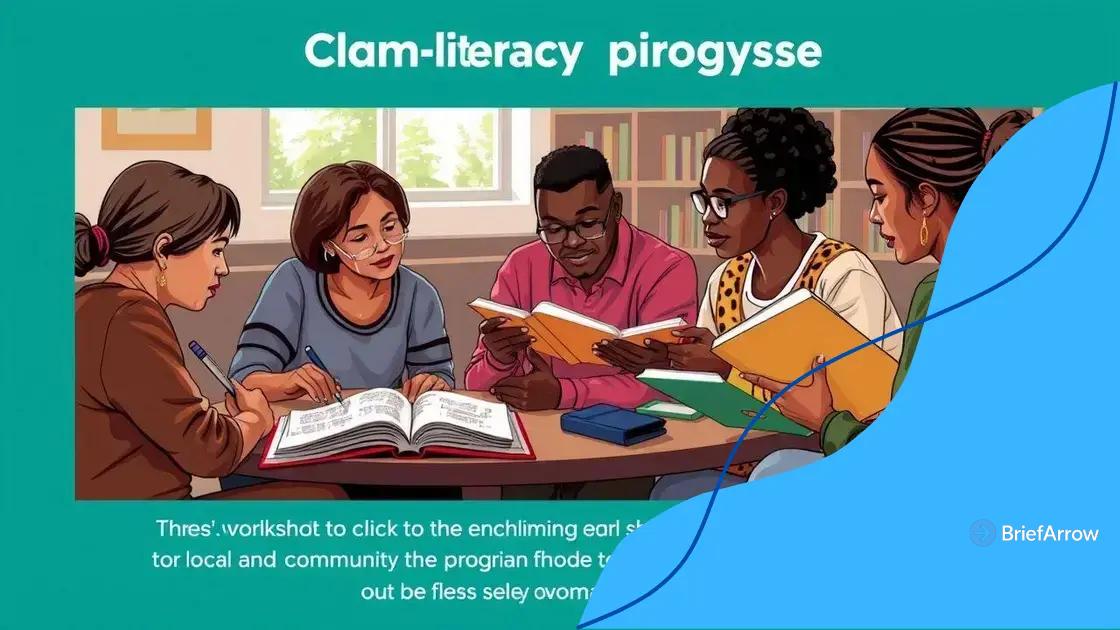Initiatives to promote adult literacy in urban areas

Anúncios
Adult literacy programs in urban areas empower individuals by providing essential reading and writing skills, leading to better job opportunities, enhanced community engagement, and improved family support.
Initiatives to promote adult literacy in urban areas are crucial for fostering inclusivity and opportunity. Have you ever considered how these programs can reshape lives and communities? Let’s dive in to explore their impact.
Anúncios
Understanding the need for adult literacy programs
Understanding the need for adult literacy programs is crucial in any urban setting. As cities grow, so does the diversity of their populations. Many adults find themselves unable to read or write effectively, impacting their daily life and opportunities.
The Challenges of Illiteracy
Illiteracy can create barriers to employment, education, and social integration. Adults who struggle with basic reading and writing skills often miss out on job opportunities and may feel alienated from their communities. It is essential to recognize these challenges as they affect not only individuals but also families and communities as a whole.
Key Benefits of Adult Literacy Programs
- Increased Employment Opportunities: Participants in literacy programs often gain skills that open doors to better jobs.
- Empowerment: Learning to read and write gives adults confidence to take charge of their lives.
- Community Growth: Literate individuals contribute positively to their communities through engagement and participation.
- Improved Quality of Life: Literacy impacts health, finances, and overall well-being.
Furthermore, adult literacy programs also provide critical support that fosters a sense of belonging. When individuals can communicate effectively, they are more likely to engage in civic duties such as voting or attending community meetings. This engagement not only enriches their lives but also strengthens the civic fabric of urban areas.
Anúncios
Addressing adult literacy should be a priority for city planners and community organizers. By providing accessible adult literacy programs, cities can help bridge the gap for many struggling residents. These programs should be tailored to meet the unique needs of their learners, ensuring inclusivity and relevance.
As we continue to explore how urban areas can thrive, prioritizing adult literacy remains an essential step towards building stronger, more resilient communities.
Successful models of urban adult literacy initiatives
Successful models of urban adult literacy initiatives demonstrate how effective strategies can transform lives. Cities around the world have implemented innovative programs that cater to the unique learning needs of adults. These initiatives thrive on community involvement and tailored approaches.
Community-Based Learning
Many programs focus on community-based learning, where local organizations work together to provide resources tailored to the residents. This collaboration helps create a more supportive environment.
- Local Partnerships: Schools, libraries, and businesses often partner to provide resources.
- Flexible Scheduling: Classes are offered at various times to accommodate working adults.
- Cultural Relevance: Materials that reflect the community’s culture enhance engagement.
Another effective model is the integration of technology into literacy programs. Online platforms allow adults to learn at their own pace, making education more accessible. Programs that offer blended learning—a combination of in-person and online instruction—have shown significant success.
Inclusivity and Accessibility
Successful initiatives prioritize inclusivity and accessibility. They ensure that programs are designed for diverse populations, including those with disabilities or language barriers. By addressing these challenges, programs can reach a wider audience.
- Language Support: Offering classes in multiple languages helps non-native speakers.
- Assistive Technology: Tools are provided for individuals with learning disabilities.
- Transportation Services: Providing transport to learners can dramatically increase participation.
Through consistent evaluation and adaptation, these programs evolve to meet the changing needs of adults. Many successful initiatives gather feedback from participants, ensuring the programs remain effective and engaging. By promoting a culture of learning, they foster environments where individuals can thrive.
As these models demonstrate, the key to successful urban adult literacy initiatives lies in community effort, adaptability, and a commitment to serving every learner. Seeing the impact of these programs on individual lives underscores the importance of investing in literacy.
Community engagement strategies for literacy

Community engagement strategies for literacy are vital for the success of adult literacy programs. When communities come together, they create a supportive environment that promotes learning. Involving local residents fosters ownership and ensures that programs meet the actual needs of the participants.
Building Partnerships
One effective strategy is building partnerships with local organizations. Schools, libraries, and businesses can collaborate to provide resources and support. When these stakeholders unite, they can create a more robust network that enhances the impact of literacy programs.
- Resource Sharing: Local businesses can provide materials or space for classes.
- Joint Events: Hosting community events raises awareness and promotes literacy.
- Volunteers: Engaging volunteers from the community can enrich the learning experience.
Another approach is to involve learners in program planning. By soliciting feedback from participants, programs can be tailored to better serve their interests and needs. This fosters a sense of community and personal investment in the success of the literacy initiative.
Creating a Welcoming Environment
A welcoming and inclusive atmosphere encourages participation. Offering classes in familiar spaces, such as community centers or churches, can help individuals feel more comfortable. Additionally, providing free or low-cost materials removes financial barriers and promotes access.
- Childcare Services: Providing childcare during classes can help parents attend.
- Food and Refreshments: Offering snacks or meals at events can encourage attendance.
- Informal Gatherings: Hosting casual meet-and-greets can build relationships between learners and instructors.
Finally, utilizing social media and local media outlets to spread awareness about literacy programs can bring in new participants. Sharing success stories and testimonials can inspire others to join and support the initiative. By continuously engaging with the community, literacy programs can ensure their relevance and sustainability.
Community engagement not only enhances literacy programs but also strengthens community ties. By working together, neighborhoods can become more educated and empowered, creating a lasting impact.
Challenges faced in urban literacy efforts
Despite the crucial importance of adult literacy programs, there are several challenges faced in urban literacy efforts. These obstacles can hinder the implementation and effectiveness of such initiatives.
Funding and Resource Limitations
One of the primary challenges is securing adequate funding. Many literacy programs rely on grants and donations, which can fluctuate. Without stable financial support, programs may struggle to provide the necessary materials and instruction. Resources such as qualified teachers and educational materials are essential for success, yet they can be difficult to obtain.
- Limited Budgets: Programs often operate on tight budgets that restrict their capabilities.
- Access to Technology: Urban areas may lack the necessary technology for modern learning.
- High Turnover Rates: Staff changes can disrupt the consistency of education.
Another significant challenge is the diverse needs of adult learners. Urban populations comprise individuals from various backgrounds, including different education levels, languages, and learning styles. Addressing such diverse needs requires adaptable teaching methods.
Social and Economic Barriers
Many adults face social and economic barriers that affect their ability to participate in literacy programs. Issues such as poverty, unemployment, and family responsibilities can prevent individuals from attending classes. Sometimes, the timing of classes does not align with the learners’ schedules, making attendance challenging.
- Transportation Issues: Lack of reliable transportation can hinder access to classes.
- Childcare Responsibilities: Parents may be unable to attend without childcare support.
- Health Challenges: Physical or mental health issues can impact participation.
Lack of awareness about available programs can also contribute to low enrollment rates. Many adults may not know that literacy initiatives exist or how they can benefit from them. Effective outreach and community engagement are essential for raising awareness.
These challenges are significant, but they are not insurmountable. By understanding the obstacles faced in urban literacy efforts, communities can implement targeted strategies to overcome them.
Long-term benefits of promoting adult literacy
Promoting adult literacy offers numerous long-term benefits that extend beyond individual learners. As communities invest in adult literacy programs, they set the stage for lasting positive changes.
Economic Advancement
One of the most significant advantages is economic advancement. Adults who improve their literacy skills are often able to secure better job opportunities. With higher literacy, they can access training programs that lead to higher-paying positions.
- Increased Earnings: Literate individuals typically earn more than their less literate counterparts.
- Enhanced Job Opportunities: Skills in reading and writing open doors to various fields.
- Workplace Efficiency: Literate employees can perform tasks more effectively, benefiting businesses overall.
This leads to a more skilled workforce, which is essential for economic growth. Additionally, communities with higher literacy rates often attract businesses, further boosting local economies.
Social Benefits
The social benefits of promoting adult literacy are profound. Literate individuals are more likely to engage in their communities. They partake in civic activities, such as voting and volunteering, which fosters a sense of belonging.
- Informed Citizens: Individuals with higher literacy can make informed decisions affecting their lives.
- Stronger Communities: Engaged citizens contribute to community development.
- Reduced Crime Rates: Literacy programs can help deter crime by providing individuals with opportunities.
These social interactions build a supportive network that encourages continued learning and growth. The more literate a community is, the more it thrives collectively.
Moreover, promoting literacy can have positive impacts on families. Parents who are literate are better equipped to support their children’s education. This creates a cycle of learning and achievement that can last for generations.
In conclusion, the long-term benefits of promoting adult literacy are clear. By investing in these programs, communities not only uplift individuals but also create a brighter, more prosperous future for everyone.
FAQ – Frequently Asked Questions about Adult Literacy Programs
What are the main benefits of adult literacy programs?
Adult literacy programs provide economic growth, improve community engagement, enhance family support, and promote lifelong learning.
How do adult literacy programs impact the community?
They foster stronger social ties, increase civic participation, and reduce crime rates by empowering individuals through education.
What challenges do these programs face?
Key challenges include funding limitations, diverse learner needs, social barriers, and a lack of awareness about available resources.
How can individuals get involved in supporting adult literacy?
People can volunteer, donate resources, or advocate for literacy initiatives in their communities to help promote these essential programs.